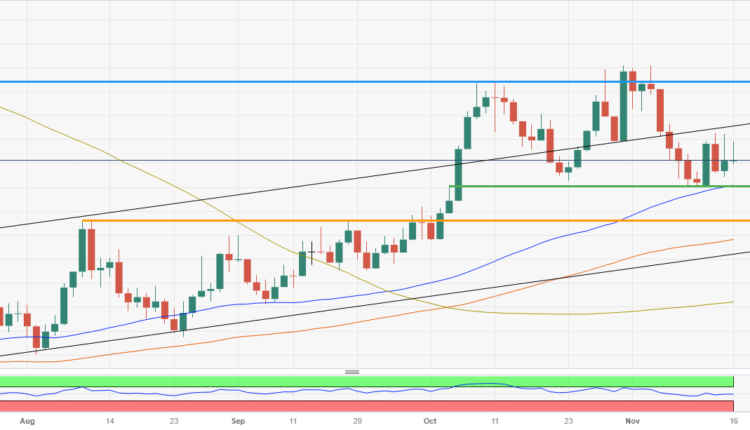Natural Gas erases Thursday’s gains as jump in US Jobless Claims dampens hope for demand uptick from US Households
- Natural Gas prices are steady in the range between $3.20 and $3.70 for November.
- The US Dollar reverses and is flirting with the low of this week in the DXY
- Natural Gas prices are expected to remain stable as both demand and supply are steady.
Natural Gas (XNG/USD) is trying to cling on to gains as an uptick in US Jobless data erases a positive mood. More broader, gas prices are starting to form a pure technical range on the charts as both supply and demand are showing signs of easing. On the demand side, positive China data could point to a quicker recovery and thus a pickup in demand from Asia’s biggest gas consumer. On the supply side, no real production hiccups or bottlenecks that could distort near-term flows are at hand.
Meanwhile, the US Dollar (USD) heads lower again ahead of the US opening bell, after the sharp decline seen on Tuesday, when US inflation data revealed further abating price pressures. With the US Federal Reserve likely done hiking, bets are rising on when the first cut will materialise, erasing the positive rate differential support for the Greenback against most major peers. Traders will keep looking for clues with the US Dollar Index (DXY) at risk to decline further.
Natural Gas is trading at $3.31 per MMBtu at the time of writing.
Natural Gas market movers: Weaker Dollar erases earlier gains
- Just ahead of the US opening bell gas prices are erasing their intraday gains as the US Dollar drops lower again on the back of higher weekly US Jobless Claims.
- Recent weather models show that a cold front is approaching Northern Europe with temperatures in Scandinavian capitals to flirt with 0° Celcius.
- European Natural Gas prices were declining earlier for a third consecutive day as robust deliveries to the bloc are avoiding pulling gas out of the storages, which are still 99% full.
- A mild start of the fall and winter season in Europe has given the bloc a bigger advantage to get through the colder period.
- The EU has issued further rules on Methane restrictions, where Liquified Natural Gas (LNG) could see more demand come in as LNG is a greener alternative to Methane use and is exempt from any emission reductions rules.
- Around 15:30 GMT, the Energy Information Agency (EIA) will issue the weekly US gas storage numbers for last week. Expectations are for an increase of 40 billion cubic feet, less than the 79 billion cubic feet seen a week earlier. Estimations range from 33 billion to 49 billion.
Natural Gas Technical Analysis: broader bandwidth
Natural Gas has found some steady ground after a rather volatile October, when the Israel-Gaza tensions were throwing Gas traders left and right. With headlines starting to fade in the region, and the EU not facing substantial shortages for this winter, it looks that Gas prices might trade in this range for some time. Unless a catalyst that either triggers substantial shortage or oversupply, a breakout isn’t expected in the coming days.
Should a proxy war in the Middle East develop, $3.64, will be the level to watch for as prices would soar. A risk premium would be priced in if Iran, Saudi Arabia and other countries in the region started mobilising forces. In such a case, even a quick sprint to $4.33, the high of 2023, could be expected.
On the downside, the 55-day Simple Moving Average (SMA) is doing its work near $3.20, based on the peak seen on October 4. In case this level is unable to hold any selling pressure, expect to see prices going down towards the orange line, from the double top in August near $3.06. That level should be able to act as the last line of defence before gas prices retreat below $3.
-638357403091927305.png)
XNG/USD (Daily Chart)
(This story was corrected on November 16 at 13:25 GMT to state that Natural Gas prices had been declining previously, not at the moment)
Natural Gas FAQs
Supply and demand dynamics are a key factor influencing Natural Gas prices, and are themselves influenced by global economic growth, industrial activity, population growth, production levels, and inventories. The weather impacts Natural Gas prices because more Gas is used during cold winters and hot summers for heating and cooling. Competition from other energy sources impacts prices as consumers may switch to cheaper sources. Geopolitical events are factors as exemplified by the war in Ukraine. Government policies relating to extraction, transportation, and environmental issues also impact prices.
The main economic release influencing Natural Gas prices is the weekly inventory bulletin from the Energy Information Administration (EIA), a US government agency that produces US gas market data. The EIA Gas bulletin usually comes out on Thursday at 14:30 GMT, a day after the EIA publishes its weekly Oil bulletin. Economic data from large consumers of Natural Gas can impact supply and demand, the largest of which include China, Germany and Japan. Natural Gas is primarily priced and traded in US Dollars, thus economic releases impacting the US Dollar are also factors.
The US Dollar is the world’s reserve currency and most commodities, including Natural Gas are priced and traded on international markets in US Dollars. As such, the value of the US Dollar is a factor in the price of Natural Gas, because if the Dollar strengthens it means less Dollars are required to buy the same volume of Gas (the price falls), and vice versa if USD strengthens.


Comments are closed.